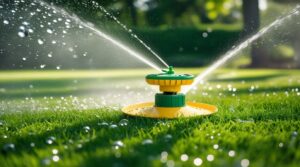Want a lush green lawn without harsh chemicals? You’re not alone. In 2025, more homeowners are embracing organic lawn care, and for good reason. Synthetic fertilizers may offer quick results, but they can harm the environment, weaken soil health over time, and pose risks to pets and kids.
That’s where organic lawn fertilizers come in. These natural alternatives nourish your grass gradually, build healthy soil, and support a more sustainable lawn care routine. Whether you’re dealing with patchy grass, dull color, or compacted soil, the right organic fertilizer can make a big difference.
In this guide, we’ll explore the best organic lawn fertilizer options on the market today, show you how to pick the right one for your yard, share application tips, and even introduce some DIY solutions. Let’s help your lawn thrive—the natural way!
Why Choose Organic Lawn Fertilizer?
When it comes to feeding your lawn, you have two primary choices: synthetic or organic fertilizers. While synthetic fertilizers are fast-acting and often cheaper, they’re made from chemical compounds that can damage long-term soil health, pollute nearby waterways, and pose risks to kids, pets, and the environment.
On the other hand, organic lawn fertilizers are made from natural materials like compost, plant meal, animal byproducts, and minerals. They work more slowly, but the results are far more sustainable and beneficial for your lawn’s ecosystem.
Here are some key benefits of organic fertilizer:
- Environmental protection: Reduces chemical runoff that harms rivers and groundwater.
- Soil improvement: Builds rich, living soil full of beneficial microbes.
- Safer for families and pets: No harmful residues or toxins on your lawn.
- Long-term results: Encourages the development of deeper root systems and more resilient grass over time.
More and more homeowners are choosing chemical-free lawn care to support a healthier planet and a safer yard. Plus, many organic fertilizers now offer comparable results to synthetic options, without the environmental cost. So, if you’re looking for a lawn care solution that supports both your yard and the earth, organic fertilizer is the smart, responsible choice.
Top 5 Best Organic Lawn Fertilizers of 2025
Choosing the right organic fertilizer can transform your lawn into a lush, green oasis. Below are five top-rated organic fertilizers that cater to various lawn care needs.
1. Down to Earth Organic Bio-Turf 8-3-5
Down To Earth Organic Bio-Turf 8-3-5 is a highly regarded organic granular fertilizer designed to promote a lush, healthy lawn while being environmentally friendly.
Key Features
-
Balanced NPK Ratio (8-3-5): Provides 8% nitrogen (N), 3% phosphorus (P), and 5% potassium (K), supporting vigorous early-season growth, robust root development, and enhanced drought resistance.
-
Organic Ingredients: Composed of feather meal, meat and bone meal, blood meal, and langbeinite, ensuring a natural nutrient source.
-
OMRI Listed: Certified for use in organic agriculture, making it safe for pets, children, and beneficial soil organisms.
-
Slow-Release Formula: Delivers nutrients gradually, reducing the need for frequent applications and minimizing nutrient runoff.
Pros:
- Encourages deep root development, reducing watering needs
- Provides a slow, steady release of nutrients
- Highly recommended by experienced gardeners
Cons:
- Higher price point compared to some alternatives
Best For: Homeowners seeking a premium, natural lawn food that promotes robust growth
2. Milorganite Slow-Release Nitrogen Fertilizer
Milorganite Slow-Release Nitrogen Fertilizer is a widely recognized organic fertilizer known for its effectiveness and eco-friendly composition.
Key Features
-
Nutrient Composition: Milorganite has an N-P-K ratio of 6-4-0, providing 6% nitrogen, 4% phosphorus, and 2.5% iron.
-
Slow-Release Formula: The fertilizer releases nutrients gradually, feeding plants for up to 10 weeks without the risk of burning.
-
Organic Matter: Composed of 85% organic matter, Milorganite enriches soil health and supports beneficial microbial activity.
-
Safety: It’s safe for use around children and pets and doesn’t require immediate watering after application.
Pros:
- Provides long-lasting, slow-release nitrogen
- Contains iron for deep greening
- Safe for use around pets and children
Cons:
- Distinct odor due to organic materials
- Availability may vary by region
Best For: Budget-conscious gardeners looking for an effective, eco-friendly fertilizer
3. Jonathan Green Organic Lawn Food 10-0-1
Jonathan Green Organic Lawn Food 10-0-1 is a premium, 100% organic fertilizer designed to nourish your lawn naturally while being safe for families and pets. Its unique formulation and eco-friendly approach make it a standout choice for homeowners seeking a lush, green lawn without synthetic chemicals.
Key Features
-
NPK Ratio: 10-0-1
Provides a high nitrogen content (10%) for robust growth, with 1% soluble potash for overall plant health. -
Organic Ingredients: Crafted from food-grade materials like feather meal, soybean meal, and blood meal, ensuring a natural feeding process.
-
Iron-Enriched: Contains 0.10% iron, promoting deep greening and enhancing the lawn’s color.
-
Slow-Release Formula: Delivers nutrients gradually over 8–10 weeks, reducing the risk of nutrient leaching and providing sustained feeding.
-
Safe for Children and Pets: Free from manure and sludge-based materials, making it safe for immediate use after application.
Pros:
- Provides gradual, consistent nutrient release for up to 10 weeks
- Enhances soil structure and promotes deep root growth
- Free from manure and biosolids
Cons:
- Higher nitrogen content may not suit all lawn types
Best For: Homeowners seeking a natural lawn food that supports long-term soil health
4. Purely Organic Lawn Food
Purely Organic Lawn Food 10-0-2 is a plant-based, slow-release fertilizer designed to promote a lush, green lawn without the use of harsh chemicals or smelly biosolids. Its unique formulation makes it a popular choice for homeowners seeking an eco-friendly and effective lawn care solution.
Key Features
-
NPK Ratio 10-0-2: Provides 10% nitrogen to support vigorous leaf growth, 0% phosphorus to comply with environmental regulations, and 2% potassium to enhance disease resistance and overall plant health.
-
Plant-Based Ingredients: Made from distiller’s dried grains and soybean meal, offering a natural alternative to traditional fertilizers.
-
Slow-Release Formula: Nutrients are released gradually, feeding the lawn for up to 8 weeks between applications.
-
Safe for Families and Pets: Contains no manure, biosolids, or harsh chemicals, making it safe for children and pets to play on the lawn immediately after application.
-
No Phosphorus Added: Meets and exceeds local environmental regulations limiting phosphate usage in municipalities across the USA.
Pros:
- Promotes thick, lush, green turf
- No harsh chemicals or smelly biosolids
- Suitable for all grass types
Cons:
- May require more frequent applications for optimal results
Best For: Families seeking a safe, plant-based fertilizer for their lawn
5. Mirimichi Green Organic Fertilizer
Mirimichi Green Organic Fertilizer is a premium, OMRI-listed product designed to enhance soil health and promote vibrant, sustainable lawns. It’s particularly favored by lawn care enthusiasts and professionals for its unique blend of nutrients and beneficial microorganisms.
Key Features
-
Balanced NPK Ratio (4-4-4): Provides equal parts nitrogen (N), phosphorus (P), and potassium (K), supporting overall plant health and growth.
-
Micronutrients Included: Contains 9% calcium (Ca) and 0.2% iron (Fe), essential for robust root development and deep green color.
-
Biological Enhancements: Incorporates beneficial fungi and bacteria to improve nutrient uptake and soil structure.
-
Slow-Release Formula: Ensures nutrients are available over time, reducing the risk of nutrient leaching and promoting sustained growth.
-
Safe for Families and Pets: Free from synthetic chemicals, making it safe for children and pets when used as directed.
Pros:
- Enhances nutrient uptake and soil health
- Provides fast green-up and recovery
- OMRI Listed for organic use
Cons:
- Premium pricing compared to other options
Best For: Lawn enthusiasts seeking a high-quality, biologically active fertilizer
Comparison Table:
| Product | NPK Ratio | Best For | Price Range |
| Down to Earth Bio-Turf | 8-3-5 | Deep root development | $$$ |
| Milorganite Slow-Release | 6-4-0 | Budget-friendly, general use | $$ |
| Jonathan Green Organic Lawn Food | 10-0-1 | Long-term soil health | $$$ |
| Purely Organic Lawn Food | 10-0-2 | Safe, plant-based option | $$ |
| Mirimichi Green Organic Fertilizer | 4-4-4 | Enhancing nutrient uptake and soil health | $$$ |
Note: Price ranges are indicative and may vary based on location and retailer.
How to Choose the Right Organic Fertilizer for Your Lawn
With numerous options available, selecting the right lawn fertilizer can be overwhelming. But the key to success lies in matching the fertilizer to your lawn’s specific needs. Here’s what to consider:
Key Factors to Consider:
- Grass Type: Cool-season grasses (like fescue or bluegrass) typically need more nitrogen in spring and fall. Warm-season grasses (like Bermuda or zoysia) thrive with nitrogen during late spring and summer.
- Soil Type: Sandy soils drain quickly and may need more frequent feeding. Clay soils retain nutrients longer.
- Climate: Wet climates may wash away nutrients faster, while hot, dry areas need slow-release options.
- Pet & Child Safety: Go for manure-free, plant-based options if your lawn is used frequently by kids or pets.
Understanding NPK for Organic Lawns
The NPK ratio represents the percentage of three essential nutrients:
- N = Nitrogen (leaf growth)
- P = Phosphorus (root development)
- K = Potassium (overall plant health)
Here’s a quick reference:
| NPK Ratio | Ideal For |
| 10-0-1 | Boosting leafy growth (spring) |
| 8-3-5 | Balanced feeding year-round |
| 4-4-4 | Steady, all-purpose lawn health |
Granular vs. Liquid Organic Fertilizer
- Granular Fertilizer: Best for slow, long-term feeding. Ideal for new or patchy lawns.
- Liquid Fertilizer: Offers quick absorption and fast results. Great for mid-season boosts or stressed lawns.
By considering these elements and understanding NPK for organic lawns, you can confidently pick the perfect fertilizer to keep your grass green, thick, and thriving—naturally.
How to Apply Organic Lawn Fertilizer for Best Results
Knowing how to apply organic lawn fertilizer the right way is just as important as choosing the right product. A proper application ensures your lawn gets the nutrients it needs, without waste or damage.
Step-by-Step Application Guide:
- Test Your Soil – Start with a soil test to understand what nutrients your lawn needs.
- Mow & Rake – Mow the lawn and remove any debris or thatch buildup.
- Use the Right Spreader – A broadcast spreader is great for larger areas, while a drop spreader is better for precision.
- Wear Gloves – Protect your hands when handling any organic materials.
- Apply evenly – Spread the fertilizer in a crisscross pattern to avoid overfeeding certain spots.
- Water Lightly – Light watering helps the nutrients absorb into the soil faster.
Common Organic Fertilizer Tips & Mistakes to Avoid:
- Don’t overapply – Organic products work gradually; more isn’t better.
- Avoid applying before heavy rain – It may wash the nutrients away.
- Skip midday applications – Early morning or late afternoon is best.
Homemade Organic Lawn Fertilizer Options
If you’re looking to save money or go fully natural, DIY organic lawn fertilizer can be an excellent solution. Many household items can double as effective, eco-friendly lawn boosters.
Easy Homemade Lawn Nutrition Ideas:
- Compost Tea – Brew compost in water to create a nutrient-rich liquid that feeds both soil and grass.
- Epsom Salt – Provides magnesium and sulfate, great for greener grass.
- Banana Peels – High in potassium; chop and bury near the root zone.
- Grass Clippings – Leave clippings after mowing to return nitrogen to the soil naturally.
Pros of DIY Organic Fertilizer:
- Cost-effective
- Environmentally friendly
- Great for small lawns and garden enthusiasts
Cons:
- Slower, less predictable results
- Requires time and consistency
- Nutrient levels may not be well-balanced without testing
While homemade lawn nutrition is great for light feeding or supplementing store-bought options, it may not replace the precision and performance of commercial organic fertilizers, especially for large or struggling lawns.
❓ FAQs About Organic Lawn Fertilizer
1. Is organic fertilizer better than synthetic?
Yes, in many ways. Organic fertilizers improve long-term soil health, encourage microbial activity, and are generally safer for the environment. While synthetic options may offer faster results, they can degrade soil quality over time.
2. Can I use organic fertilizer year-round?
Organic fertilizers can be applied in multiple seasons, but timing matters. For most lawns, spring and fall are the best times. Avoid heavy applications in winter when grass is dormant.
3. How long does organic fertilizer take to work?
Unlike synthetic fertilizers, which act quickly, organic fertilizers work gradually. You’ll typically start seeing results in 2–4 weeks, depending on conditions like temperature and moisture.
4. Will it green my lawn fast?
Organic fertilizers are more about sustainable lawn care than quick fixes. While they do encourage greening, they do so steadily, improving root strength and long-term resilience.
5. Is organic fertilizer safe for pets and kids?
Absolutely. Most natural lawn fertilizers are free from harmful chemicals, making them a top choice for families who use their yard frequently.
Final Verdict
In 2025, the best organic lawn fertilizers combine performance with sustainability, safety, and effectiveness. While Mirimichi Green and Espoma offer some of the best overall results for organic lawn care, products like Milorganite and Purely Organic Lawn Food provide excellent options for those on a budget or those focused on phosphorus-free, environmentally friendly products.
Ultimately, the right fertilizer depends on your unique needs:
-
For a truly sustainable option with added soil health benefits, Mirimichi Green is a top contender.
-
For a quick greening solution, Jonathan Green Organic Lawn Food delivers rapid color and vibrancy.
-
For eco-friendly and budget-conscious gardening, Milorganite and Purely Organic Lawn Food are excellent choices.
No matter which product you choose, remember that organic fertilizers are not just a way to feed your lawn but an investment in your yard’s overall health, soil quality, and the environment!















